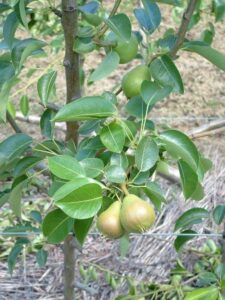
Pollination – realising the potential
By John Fitzsimmons
Growing food at home has been trending in recent times. Many who started out with easily grown herbs and vegetables have advanced to perennial crops including fruit trees. However, the full reward from this step could be limited if pollination is not considered.
With the increased availability of dwarf selections and grafted varieties, especially when combined with espalier and other vertical plane or ‘wall’ type training systems, many fruit trees can be used in landscape designs in a greater variety of ways. It also means that engaging landscape designs can also be productive.
For commercial fruit growers a maximised yield is an economic imperative. In these settings many growing options are employed that would not be practical or acceptable in a home landscape setting. This priority might not be so true for ‘home gardeners’ or those on small blocks. Here aesthetics, scale, time, and skills available will likely be weighted differently.

However, even if some modest fruit production is desired or expected then nature’s pollination rules must be acknowledged. Especially for garden centre staff who have been focused on ornamentals, there are likely to be some feedback and questions from customers along the lines of “why is the apple tree you sold me not fruiting?’ or “is this all I need to grow oranges?” In many cases the answers may involve flowering, pollination, or a failure to pollinate. Re-visiting appropriate training materials will often be rewarding. And fruit tree production nurseries and suppliers usually offer appropriate advice and support for the retailer’s sales of their lines.
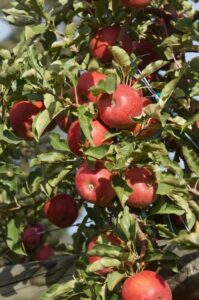
So, first, a little basic ‘birds and bees’ botany. The first requirement is flowers. Understanding the physiology (or structure) of flowers is a vital first step. The stamen is the pollen-producing part of a flower, usually with a slender filament supporting the anther which is that part of the stamen where pollen is produced. The pistil is the ovule-producing part of a flower and consists of the stigma (which receives pollen), the style, and ovary. Consideration of the timing (seasonality) and length of flowering is also important in relation to the presence (or otherwise) of suitable pollen and pollinators.
Pollination involves the transfer of pollen grains from the anthers to the stigmas of flowers. It occurs when pollen is effectively transferred:
- from the anthers to the stigmas of the same flower
- to stigmas of different flowers on the same plant
- and to the stigmas of flowers on different plants.
Fertilisation follows when the pollen grains germinate on the stigma and are sent down a pollen tube releasing the sex cells to fertilise the ovules. After fertilisation, the ovules become the seeds, and the ovary wall becomes the fruit. If the flower is not satisfactorily pollinated, the fruit may be malformed or drop off.
As detailed above, there are several categories* to consider in the pollination of fruiting plants including:
Hermaphrodite – where each plant has individual flowers that are both male (produce pollen) and female (produce ovaries). These flowers often require insects to move pollen from the male parts of the flower to the female parts to set fruit. Fruit set can also be limited by the degree of pollen self-compatibility. Examples include apple and blueberry.
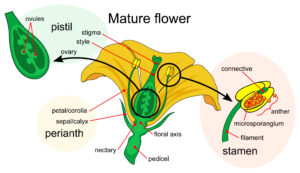
Most apples have flowers which contain only stamens (the ‘male’ part of the flower) while others contain only ‘female’ pistils. Without both elements existing on the same tree, these varieties cannot be self-fertile, therefore they require cross-pollination from nearby compatible fruit varieties to produce fruit. This means not all apple varieties will effectively pollinate other apples (see below).
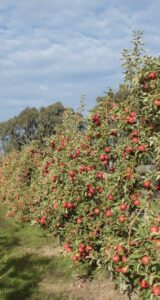
‘Self-fertile’ trees don’t require cross-pollination from a different variety to produce fruit. But they still require pollination (pollen moving from the stamens of one flower to the pistils of the next within the same variety, or from stamens to pistils in the same flower) to produce fruit. Self-fertile trees contain both the male and female parts of the flower so can fertilise themselves.
All varieties of apricot, nectarine, and peach are considered self-fertile.
Monecious – where each plant has individual flowers that are either male or female. These flowers also often require insects to move pollen from the male flowers that are separate to the female flowers to set fruit. Fruit set can also be limited by the degree of pollen self-compatibility. Examples include watermelon and pumpkin.
Dioecious – where each plant has individual flowers that are exclusively either male or female. These flowers often require insects to move pollen from the male plants that are separate to the female plants to set fruit. An example is kiwifruit.
Pollen compatibility can be regarded as:
Self-compatible: Pollen self-compatible crops can successfully develop fruit and seeds when the flowers are fertilised with pollen from the same flower, plant or cultivar as the mother plant, or other compatible cultivars. The degree of self-compatibility can vary between cultivars. Many cultivars that are self-compatible still show increases in yield and/or fruit quality when cross pollinated (pollen from a different plant, cultivar or variety).
Cultivar dependent: Different cultivars of the same crop vary in the degree of pollen self-compatibility. Some cultivars of a crop may require abundant pollen to be transferred from a different variety to successfully develop fruit and seeds, while other cultivars do not. The degree of cultivar-dependent pollen self-compatibility influences the extent of mixed variety plantings and the number of pollinator visits required to successfully produce fruit and seeds.
Self-incompatible: Pollen self-incompatible crops only develop fruit and seeds when the flowers are fertilised with pollen from a different cultivar to the mother plant. Pollen self-incompatible crops require mixed cultivar planting arrangements and often benefit from a high abundance of insect pollinators to transfer pollen between plants for successful fruit and seed formation.
Pollination charts
Fruit tree propagators should be able to supply you with appropriate pollination charts for crops and varieties suited to your climatic region. As an example, Table 1 references some pollination compatibility relationships for selected apple varieties.

In addition to sexual compatability of flowers, timing compatibility refers to the seasonality of flowering. There are similar benchmarking reference charts for different varieties of most fruits. For example, see Table 2.
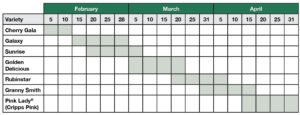
Note the possible date range/s when compatible pollinators need to be present and flowering for different varieties. These date ranges will also vary somewhat according to various location criteria such as latitude and altitude, climatic factors such as chill, plus seasonal variations and immediate site characteristics.
In commercial production this varietal spread of maturity allows the grower to spread harvest and storage resources over a longer period and avoid overloading capacity. For the home grower it can extend the period to enjoy ‘fresh from the tree’ produce.
Grafting
It’s worth pointing out that some propagators can also supply multiple varieties grafted onto suitable rootstocks, and often these varieties meet the various pollination compatability needs on one plant. Handy. This approach also means multiple fruit options can be produced off much smaller areas, with fewer trees extending interest and taste options.
Pollinators
While most of us quickly think of the European honey bee (Apis mellifera) as a common pollinator,
bumblebees – large, hairy, social bees belonging to the family Apidae (subfamily Bombinae) and not native to Australia – are used commercially overseas to pollinate certain glasshouse and field crops. The large earth bumblebee (Bombus terrestris) has established in Tasmania but Victoria deems bumblebees a potential threat to the environment and primary production. More than 1600 other native bees have been recognised as being active pollinators in various regions across the continent. However, flies, beetles, butterflies and moths, wasps and even mosquitos have been linked to pollination in different locations and scenarios. The wind can also sometimes play a role, while some manual human assistance using brushes or other small tools (e.g. beaters) can be employed in the appropriate circumstances.
Of course, planting non-cropping ornamentals and other pollinator-attracting plants in the neighbourhood of our fruit trees can contribute significantly to fruit tree pollination success, as well as contribute to the landscape’s aesthetic appeal.
While we should value the contribution collectively made to our plant and food production systems by our pollinators, they face many challenges. Incursions by biological threats such as Varroa mite have impacted bee populations. Natural events including fire and flood have decimated pollinator populations and habitat. Dry seasons have also impacted pollinator presence and survival. Urban sprawl and development have similarly impacted habitats broadly, and inappropriate or untimely use of insecticides are a constant threat. While of less significance in domestic landscapes than in some contemporary re-constructed and re-formatted orchards, pollinators can also be disrupted by having to navigate continuous dense plant canopies; they still need the ability to forage efficiently and still find their way ‘home’.
So, by all means promote truly ‘home grown’ fruit, but remember the natural system that underpins the arrival of an ample tasty crop.
*A guide to Australian crop pollinating insects. Romina Rader (University of New England/Rader Community Ecology Lab), Bryony Willcox (UNE), Katja Hogendoorn (University of Adelaide), Saul Cunningham (Australian National University), Tanya Latty (University of Sydney), Scott Groom (HILT CRC) and Jeremy Jones (UNE). Published by Australian Government-Agrifutures
